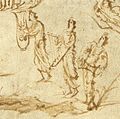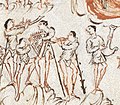 Triangular psalteries held as harps in the Cantigas de Santa Maria, Musician's Codex, 1280 A.D. On the near face of each rotte, 17 strings are visible. | |
| String instrument | |
|---|---|
| Other names | rotte, rote, rotta, rota |
| Hornbostel–Sachs classification | 314.122 box zithers ((Box zither. Chordophone with one or more strings stretched between fixed points, a board for a string bearer, parallel to the plane of the strings, with a resonator box)) |
| Related instruments | |
| |
- See Rotte (lyre) for the medieval lyre, or Rote for the fiddle
During the 11th to 15th century A.D., rotte (German) or rota (Spanish) referred to a triangular psaltery illustrated in the hands of King David and played by jongleurs (popular musicians who might play the music of troubadours) and cytharistas (Latin word for a musician who plays string instruments). [1] [2] Besides being played in popular music, the church may have used them as well; a letter from Cuthbert, Abbot of Jarrow, England survives, in which he asks an archbishop to send him a cytharista to play the rotta. [2]
Contents
The instruments least 10 strings on each side and were held like a harp in front of the musician. [1] [3] Rottes were also described as having 17 stings and 22 strings on each side. [2] The playing position was different from other psalteries, as the Rotte might be held like a harp, leaned sideways (flat against the musician's chest), or rested on the lap. [4] Two styles of rotte have been inferred from images: the first is a triangular box with strings on one side, the other has strings on both sides (both hands playing at once, resembling a harp). [1] The instruments are shown played with both plectrum and with fingers. [1]
The names chrotta, rotte, rotta, rota and rote have been applied to different stringed instruments, including a psaltery, lyre and to a Crwth (necked lyre played as a fiddle or lute). [3] [5] [6] In the 15th century it was also used to name a fiddle, synonymous with the rebec. [3]
Knowing a rotte (psaltery) from a triangular harp in the medieval miniatures can be challenging; rottes may have sound holes visible, if the artist is putting that level of detail into the painting. [7] Similarly, harps show background through the strings if the artist painted sufficient detail.






























